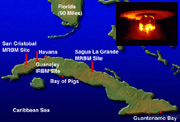| |
: Dates
Major Treaties:
Historic Figures:
Historic Events:
|
|
|

"Nuclear catastrophe was hanging by a thread ... and we weren't counting days or hours, but minutes."
Anatoly Gribkov, Soviet General and Army Chief of Operations
|
The Cuban Missile Crisis was the closest the world ever came to nuclear war. The United States armed forces were at their highest state
of readiness ever and Soviet field commanders in Cuba were prepared to use battlefield nuclear weapons to defend the island if it was invaded.
Luckily, thanks to the bravery of two men, President John F. Kennedy and Premier Nikita Khrushchev, war was averted.
In 1962, the arms race between Soviet Union and United States was escalating. Soviet missiles were still only powerful enough to be launched
against Europe but U.S. missiles were capable of striking the entire Soviet Union from their installations in Turkey. In late April 1962, Soviet Premier
Nikita Khrushchev conceived the idea of placing intermediate-range missiles in Cuba. A deployment in Cuba would double the Soviet strategic arsenal
and provide a real deterrent to a potential U.S. attack against the Soviet Union.
Meanwhile, Fidel Castro was looking for a way to defend his island nation from an attack by the U.S. Ever since the failed Bay of Pigs invasion
in 1961, Castro felt a second attack was inevitable. Consequently, he approved of Khrushchev's plan to place missiles on the island.
In the summer of 1962 the Soviet Union worked quickly and secretly to build its missile installations in Cuba.
For the United States, the crisis began on October 15, 1962 when reconnaissance photographs by U-2 spy plane revealed Soviet missiles
under construction in Cuba. Early the next day, President John Kennedy was informed of the missile installations. Kennedy immediately
organized the EX-COMM, a group of his twelve most important advisors to handle the crisis. After seven days of guarded and intense debate
within the upper echelons of government, Kennedy concluded to impose a naval quarantine around Cuba. He wished to prevent the arrival
of more Soviet offensive weapons on the island. On October 22, Kennedy announced the discovery of the missile installations to the public
and his decision to quarantine the island. He also proclaimed that any nuclear missile launched from Cuba would be regarded as an attack
on the United States by the Soviet Union and demanded that the Soviets remove all of their offensive weapons from Cuba.
During the public phase of the Crisis, tensions began to build on both sides. Kennedy eventually ordered low-level reconnaissance missions
once every two hours. On the 25th Kennedy pulled the quarantine line back and raised military readiness to DEFCON 2. Then on the 26th
EX-COMM heard from Khrushchev in an impassioned letter. He proposed removing Soviet missiles and personnel if the U.S. would guarantee
not to invade Cuba. October 27 was the worst day of the crisis. A U-2 was shot down over Cuba and EX-COMM received a second letter
from Khrushchev demanding the removal of U.S. missiles in Turkey in exchange for Soviet missiles in Cuba. Attorney General Robert Kennedy
suggested ignoring the second letter and contacted Soviet Ambassador Anatoly Dobrynin to tell him of the U.S. agreement with the first.
Tensions finally began to ease on October 28 when Khrushchev announced that he would dismantle the installations and return the missiles
to the Soviet Union, expressing his trust that the United States would not invade Cuba. Further negotiations were held to implement
the October 28 agreement, including a United States demand that Soviet light bombers be removed from Cuba, and specifying the exact form
and conditions of United States assurances not to invade Cuba.
SEE ALSO
|
|